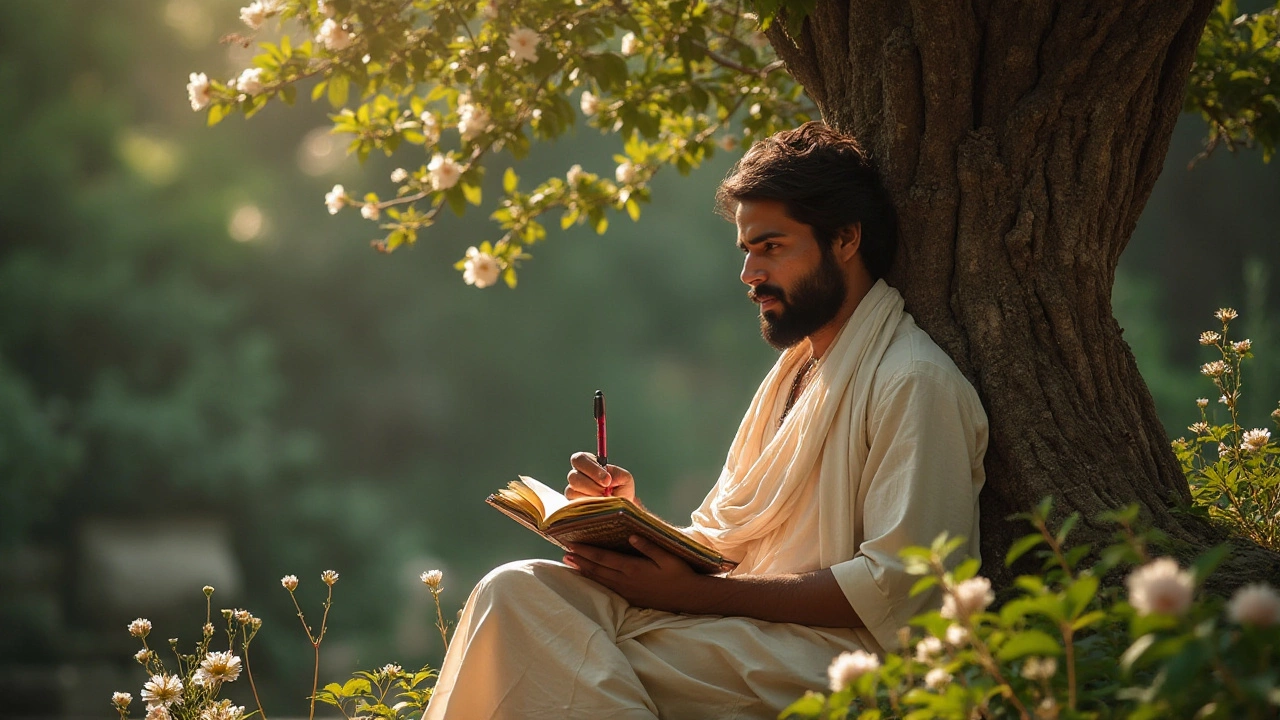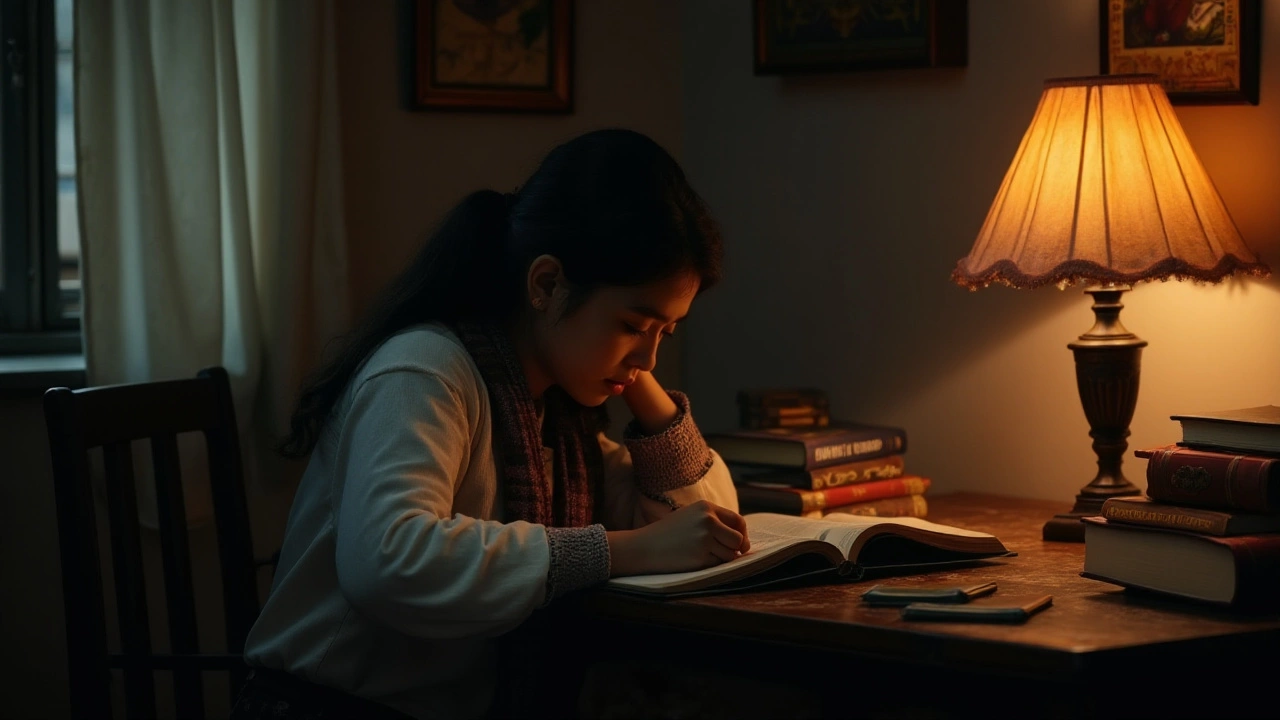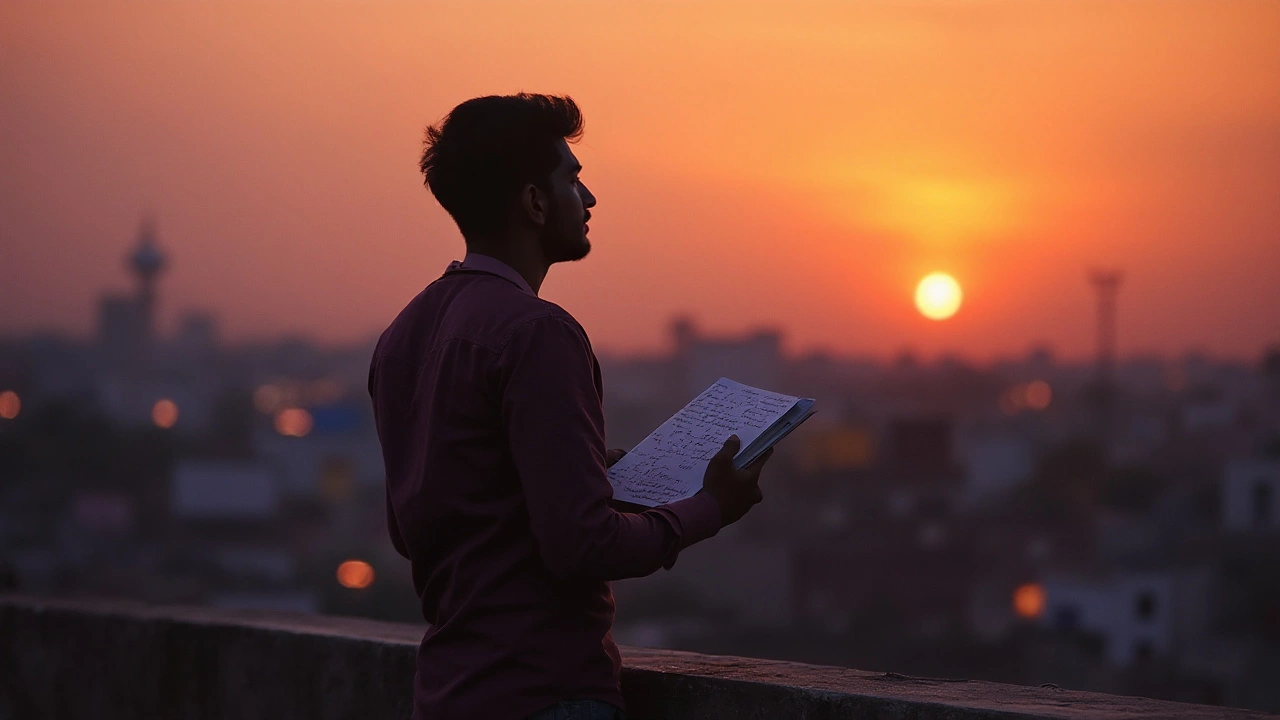Exploring Melancholic Personality Types through Indian Sad Poetry
 Jan, 2 2025
Jan, 2 2025
In the vast tapestry of human temperament, certain personality types stand out for their distinctive traits and profound depth. Among these, the melancholic personality is both enigmatic and fascinating, offering a unique lens through which to understand the world. These individuals are often deeply introspective and have a natural affinity for art, particularly poetry.
In India, where the emotional spectrum is celebrated in its vibrant literary traditions, melancholic personalities find a rich and expressive outlet in sad poetry. This ancient craft, steeped in pathos and introspection, has a way of resonating with those who dwell in the shadowy corners of the human experience. It’s through the careful weaving of words and emotions that one begins to grasp the beauty and complexity of melancholic individuals.
Understanding the intricacies of melancholic personality types is not just an exercise in self-awareness but a journey into the heart of Indian literature. In this exploration, we delve into the characteristics that define these personalities, their historical connection to sad poetry in India, and the influential poets who have crafted timeless works that speak to their core. By appreciating the interplay between melancholy and creativity, we open doors to new interpretations and insights into the contemporary world of Indian writing.
- Understanding Melancholic Personality Traits
- The Connection Between Melancholy and Creativity
- Indian Sad Poetry: A Historical Perspective
- Prominent Indian Poets and Their Melancholic Works
- How Melancholy Inspires Modern Indian Writers
Understanding Melancholic Personality Traits
Melancholic personality types are often deeply reflective, with a penchant for introspection that rivals their propensity for analytical thought. These individuals are typically characterized by their conscientious nature and their ability to ponder life’s deeper meanings. Their inner worlds are rich and textured, filled with thoughts and emotions that run deep. They tend to find solace in routines, valuing structure and discipline in their lives as it helps them maintain a sense of control over the swirling emotions they experience.
A hallmark of the melancholic personality is their profound emotional depth. It's not unusual for a melancholic person to dwell on past events, replaying memories and minor details in their minds. This introspection often leads to feelings of nostalgia and even sadness, but also provides a wellspring of creative energy. Many artists and writers, especially those involved in sad poetry, channel these intense feelings into their work, which can be both cathartic and inspiring. The desire to understand and articulate emotions through art makes melancholic individuals naturally drawn to poetry.
The careful attention to detail and systematic thinking of melancholics means they are frequently meticulous and reliable. People with such personalities excel in professions where precision and accuracy are valued. However, their high standards can also lead to perfectionism, making them overly self-critical and prone to procrastination if things aren't flawless. This need for perfection often extends to their personal relationships. They cherish long-term bonds and are fiercely loyal, although they can sometimes struggle to express their innermost thoughts and feelings, preferring instead to convey them through poetry or other creative outlets.
According to ancient humorism, "Melancholics are wise yet temperate, sorrowful yet sensitive, pragmatic yet prudent."
Interestingly, the melancholic disposition also lends itself to an appreciation for life's minor details, which often go unnoticed by others. They are known for their meticulousness, excellence in organizational skills, and a penchant for tidiness. They often feel comfortable when they can predict outcomes, which aligns with their love for well-thought-out plans and strategies. Anxiety over the unpredictable can be prevalent among melancholics, yet this only fuels their dedication to prepare and protect themselves from potential mishaps.
Social interactions with melancholics can reveal layers of their complex characters. At first glance, they might appear reserved or even distant. However, beneath this exterior lies a reservoir of empathy and sensitivity. They are adept listeners and often provide insightful advice. Their empathic nature allows them to connect profoundly with others, though this deep empathy can sometimes lead to emotional overwhelm. Protecting their inner peace, they prefer solitude or small, intimate gatherings over large social events. Nevertheless, their friendships, once formed, are resilient and enduring.
The Connection Between Melancholy and Creativity
The link between melancholic personality traits and creative expression has intrigued thinkers, artists, and psychologists for centuries. Those with a melancholic disposition often possess a remarkable emotional sensitivity, which can serve as a rich wellspring for artistic creativity. This sensitivity allows them to deeply perceive and articulate the complexities of human emotions, a quality that resonates profoundly with readers through various artistic mediums.
Historically, many celebrated poets and artists have been described as melancholic, with their creations offering deep introspection into the human condition. In ancient India, poets like Mirza Ghalib and Rabindranath Tagore are often remembered for their ability to express profound sorrow and longing in their writings. Their works encapsulate the essence of Indian poetry and showcase how melancholy can catalyze breathtaking creative manifestations.
One reason for this connection is that melancholic individuals tend to be highly reflective and analytical. This natural inclination towards introspection can lead to a greater understanding of life's subtleties, enabling artists to portray authentic and relatable experiences. As the famous philosopher Aristotle once suggested, there's a certain wisdom in melancholy that provides clarity and insight, allowing artists to explore themes of existentialism, love, loss, and redemption with unprecedented depth.
"Melancholy, when not exaggerated, is the mother of genius." – John Keats
The creative process for melancholic individuals often involves channeling their inner experiences into their art, constructing a bridge between their internal world and the outer realm. This journey of translation not only provides a release and a means of self-expression but also invites others to share in their perspective, creating a universal connection through the beauty of art. This expressive capacity is particularly well-suited to sad poetry, an art form that thrives on exploring the intricacies of emotional experiences.
Moreover, understanding the biological underpinnings of creativity in melancholic individuals adds another layer of depth to this discussion. Some research suggests that the biochemical pathways influencing emotional states might also fuel creative thinking. This could explain why many artists find their greatest inspiration during periods of heightened emotional activity when they experience a symphonic alignment between feeling and creation.
In modern times, the influence of melancholic creativity continues to pervade, as contemporary writers and poets draw upon this timeless tradition. The digital age has ushered in new platforms for sharing poetic works, connecting people worldwide who relate to the soulful expressions rooted in melancholy. As these creatives bring fresh voices to the forefront, they keep alive the rich tradition of using melancholy as a vital source of creativity, enriching the cultural landscape with diverse narratives that challenge, soothe, and inspire.

Indian Sad Poetry: A Historical Perspective
Indian sad poetry, with its deeply woven threads of emotion and introspection, has its roots embedded in the rich and diverse landscape of India's cultural history. To unravel the evolution of Indian poetry is to embark on a journey through time, one that reflects the intricate blend of social, cultural, and individual narratives that have shaped this timeless art form. This tradition dates back to ancient texts such as the Vedas, where the longing for understanding and the human condition were poignantly expressed.
Amidst the poetic expressions, the melancholic verses of poets such as Mirza Ghalib and Faiz Ahmed Faiz stand out prominently. Ghalib, in the 19th century, was renowned not just for his mastery of the Urdu language but also for his ability to infuse his poetry with a sense of deep personal melancholy, capturing the essence of human despair in the face of unfulfilled desires and existential reflections. As he once eloquently penned, the struggles and lamentations of life were akin to a constant companion. Moving into the 20th century, Faiz Ahmed Faiz further encompassed this tradition, with his poignant reflections on societal woes and individual strife resonating with generations.
The intricacies of melancholic personality types are often mirrored in the stylings of classical Indian poets, whose work delves into themes of love, loss, and yearning. The Bhakti and Sufi movements emerge as notable incubators for such poignant compositions. The Bhakti poets, for instance, harnessed a deep sense of devotion intertwined with personal despair, articulating a unique blend of spiritual longing and worldly sorrow. Meanwhile, the Sufi traditions, with their mystical and often somber philosophies, brought forth ghazals and compositions that pondered the depths of existence and the eternal quest for the divine. These themes, though rooted in religious tradition, communicate a universal sorrow and introspection characteristic of melancholic personalities.
As the modern era approached, Indian sad poetry continued to evolve, absorbing and reflecting the changing societal landscape. The post-independence period, marked by both exhilaration and disillusionment, found its voice in poets who grappled with the murky waters of a new identity, a new dawn shadowed by untold struggles. This era brought forth a new wave of poets who merged traditional forms with contemporary concerns, creating a tapestry that speaks to the melancholic yet resilient spirit.
In recognizing the historical backdrop of Indian sad poetry, one appreciates not just the art itself but the poignant narratives that underscore them. This literary exploration highlights the timeless connection between melancholy and creativity, demonstrating how these introspective expressions have become a sanctuary for understanding in an ever-evolving world. It is these poets’ ability to capture the complexities of the human experience that continues to inspire and resonate with readers across the globe, offering solace and understanding through their profound and soul-searching verses.
Prominent Indian Poets and Their Melancholic Works
In the realm of Indian literature, certain poets have excelled in bringing the intricacies of the melancholic personality to life through their poignant writings. These poets, adept in weaving heart-wrenching stanzas, have given a voice to emotions often left unspoken. One such luminary is Mirza Ghalib, whose ghazals resonate with an intense emotional depth that seeks to explore the labyrinth of human sorrow and longing. Ghalib's verses often dwell on the transience of life and the eternal quest for love, wrapped in metaphors that mirror the moodiness of a melancholic personality.
Rabindranath Tagore, a maestro of both joy and sorrow, offers a profound exploration into the depths of human emotions. His works, such as 'Gitanjali,' delve into the subtle nuances of melancholy, capturing the essence of introspection and existential angst. Tagore's mastery lies in his ability to convey complex feelings through deceptively simple phrases, making his poetry accessible yet deeply resonant. His eloquent lines invite readers to reflect on the nature of their inner turmoil, finding beauty and solace amidst the sorrow.
Sarojini Naidu, known as the 'Nightingale of India,' further enriches this tapestry of melancholic expression through her lyrical poetry. Naidu's poems often highlight the bittersweet nature of nostalgia and loss. Her words transport readers into a world where pain is embraced as an intrinsic part of the human journey. She draws from Indian traditions and personal experiences to craft verses that are both an ode to melancholy and a celebration of resilience.
"The art of losing isn't hard to master; so many things seemed filled with the intent to be lost that their loss is no disaster." – Elizabeth Bishop, reflecting the universal theme of accepting loss, echoed in melancholic poetry.
Another pivotal figure is Kamala Das, whose bold and candid exploration of personal anguish and identity set a new precedent for modern Indian poetry. Her work addresses the struggles of womanhood and the confines of societal expectations, providing a raw glimpse into the emotional landscape of a melancholic personality. Das's poetry bravely tackles themes of alienation, desire, and the search for self, resonating deeply with readers who see reflections of their own experiences in her writings.
Sahir Ludhianvi, with his unique blend of Urdu poetry and cinematic lyrics, captures the pulsating agony and poignant reflection of an era marked by turbulence. His poems often traverse themes of love, heartbreak, and social injustice, striking a chord with audiences through their emotional candor. Ludhianvi's ability to paint vivid pictures with words makes him a standout figure in capturing the essence of melancholy in both personal and societal contexts. Combined, these poets illustrate the remarkable ability of Indian sad poetry to transcend time, providing both a mirror and balm for the soul.

How Melancholy Inspires Modern Indian Writers
For centuries, the currents of melancholy have flowed through the veins of Indian literature, nourishing its poignant and reflective nature. Today, modern Indian writers continue to draw from this deep well of emotion, using the sorrowful beauty found in their predecessors’ sad poetry as a means to explore and express the complexities of contemporary life. The unearthing of melancholy as a source of inspiration often leads authors to question societal norms, reflect on personal experiences, and convey the unspoken nuances of human emotions through their narratives.
The influence of melancholic tones can be traced in the works of several prominent contemporary Indian authors. From Arundhati Roy to Vikram Seth, the subtle interplay of sadness and introspection provides a rich backdrop against which stories unfold. Their stories often capture the essence of longing and introspection, unveiling layers of human experience that resonate deeply with readers. This exploration into the melancholy is not merely designed to evoke sadness but pursues the deeper intention of understanding the intricate emotions inherent in human existence.
The ability to craft such emotionally impactful stories lies in the writers’ profound understanding of their heritage and personal experiences. Often, melancholy prompts them to delve into the crises of identity, post-colonial struggles, and familial relationships that define much of Indian society. These themes have the power to evoke universal emotions. As Indian writers traverse this complex terrain, the melancholic undertones in their poetry and prose provide a mirror that reflects both personal and collective existential questions, making their works timeless and universally applicable.
The compulsion to infuse writings with a touch of melancholy is partly derived from a cultural context that reveres emotional transparency. Indian culture has historically embraced a wide spectrum of emotions, acknowledging their rightful place in influencing the human psyche and the creative process. The melancholic dimensions in literature not only enrich character development and narrative depth but also bridge the gap between fiction and a deeper reality. By ensuring their characters and themes remain relatable, writers maintain a profound connection with their audiences, inviting them to embark on a journey of shared reflection and discovery.
"Melancholy is the happiness of being sad," once mused Victor Hugo. This profound contradiction holds particular significance for Indian authors who often capture the delicate balance between despair and joy in their works. Melancholic personality traits enable them to perceive art in the mundane, transforming everyday life into powerful tales interwoven with deep emotional resonance.
The duality inherent in melancholy further equips modern writers with the emotional tools necessary to address topics ranging from environmental concerns to political upheaval. By presenting a melancholic view of current issues, they bring an emotional and empathetic dimension to the conversation, encouraging readers to critically engage with the world around them. The enduring legacy of melancholy in Indian poetry and literature thus acts as both a catalyst and a canvas for modern writers, guiding them as they pen new works that confront, challenge, and captivate their readers.
Embracing melancholic themes is more than just a stylistic choice for modern Indian writers—it is an essential part of their storytelling arsenal, enabling them to highlight societal dichotomies and the indefinable aspect of the human experience. By tapping into this tradition, they continue to pave the way for future literary voices, ensuring the influence of Indian sad poetry never fades away, but instead, evolves with time, forever a testament to the enduring power of sorrowful beauty in literature.